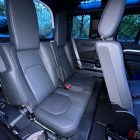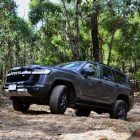Off-road vehicles are no longer just off-road vehicles these days. Market demands have dictated that they must do a lot more than just bush-bashing. They’re big and spacious comfortable daily drivers packed with creature comforts and the latest tech. Their rugged 4×4 mechanisms, while still as capable as ever, are mostly hidden away for more a refined driving experience. And they now look miles better than their earlier forebears. Today, they’re better known as lifestyle vehicles.
Two of the biggest nameplates in this segment are the Toyota LandCruiser and Land Rover Defender. Both started life as military vehicles, they have since morphed into civilian transports, each with a rich heritage spanning over seven decades. Direct rivals from inception, here they are in their respective latest generation model, facing off against each other once again.
The Toyota LandCruiser Series 300 sees a new addition to the line-up in the form of the GR Sport, and that’s what we have on test here. The GR Sport slots below the flagship Sahara in the range, priced from $142,100 plus on-road costs. It’s competitor on test, the Land Rover Defender 110 D300 X-Dynamic HSE comes in at $120,310 but is loaded with options to be slightly better spec’ed than the LandCruiser. The final sticker for the Defender is $134,609 plus on-road costs.
On the outside
The LandCruiser is the first completely new model in about a decade and from the outset it looks the business. This is a huge vehicle but the proportions are spot on and there’re some nice design elements around the vehicle such as those bonnet bulges and boxed wheel fenders.
The GR Sport grade brings about some sporty and off-road focused touches, too, including a blacked out grille with Toyota block letters replacing the Toyota logo, black side mirrors and black window surrounds. These are matched with GR Sport specific front and rear bumpers with silver front bash plate, black wheel guards and matte grey 18-inch wheels. A sprinkle of GR badges around the car completes the sporty look.
The latest generation Defender represents the biggest transformation in the history of this nameplate. The previous utilitarian design has been completely modernised and the result is a stunning expression of contemporary style and go-anywhere toughness. The new styling is unapologetically boxy, a preservation of its roots, yet alluringly cool.
Like the GR Sport, the X-Dynamic variant on test boasts an off-road ready look with some nice sporty upgrades. There’s a generous application of gloss black detailing around those lower exterior trims, matched with a black roof and black spare wheel cover. The rest of the car is finished in white, creating a striking contrast against the black accented body detailing and those optional 20-inch satin grey wheels.
While the new LandCruiser looks as prominent as ever on the road, it just can’t match the latest Defender in utter coolness. The latter is a head-turner, especially when perfectly spec’ed like our test car, exterior wise.
On the inside
The interior of the LandCruiser ticks most boxes in terms of presentation, comfort and practicality. The layered dashboard design allows buttons and knobs to be positioned where they should be, offering excellent ergonomics. While the 9.0-inch centre touchscreen is larger than before, it’s glad to see Toyota hasn’t moved all controls onto the screen. Essential functions like climate control, media and four-wheel drive settings are all still operated by physical controls. This is important for a vehicle like the LandCruiser, as you don’t want to be fiddling through the touchscreen to change settings while driving off-road – especially when you have your gloves on.
The infotainment system supports Apple Carplay and Android Auto, delivering good quality audio through a JBL 9-speaker system. Much of the touchscreen interface is recycled from the previous Lexus (Toyota’s luxury offshoot) system. It’s fit for purpose but there’s still much to improve on the voice command recognition and satellite navigation. A wireless phone charger is also included.
A couple of GR badges are littered around the cabin, which along with the dark headliner, distinguish the GR Sport grade interior from the rest of the line-up. It does feel suitably sporty inside, and from the driver’s seat, with the elevated sitting position and large steering, it feels pretty commanding as well.
Both from and rear seats are very comfortable, and as you’d expect from a large wagon there’s heaps of space for everyone onboard. While you can have an additional third row of seating in other LandCruiser variants, the GR Sport is strictly a 5-seater without a third row. So, if you haven’t overbred the GR Sport is the ideal model for a customised cargo area. With 1131 litres of boot space to play with, there’s plenty of room for anything from storage drawers to a slide-out kitchenette. Fold the second row seats, the space expands to 2052 litres.
While the LandCruiser’s interior is pretty conventional, that of the Defender is anything but. It’s a pretty good modern interpretation of earlier Defender models. It’s cool yet functional. It’s contemporary yet soulful. The adventurous design of the dashboard and door cards is done so tastefully and with so much respect of its roots that you’ll not mistaken it for the cabin of another car. It’s a pretty special place to be in.
The tech is more advanced than that of the LandCruiser. As part of the Defender’s mid-life update, the infotainment touchscreen has been up sized to 11.4-inch. It’s accompanied by a fully digital driver instrumentation display. Both screens are ultra crisp, with the digital driver display offering good customisability including the ability to display a full map view. What the Defender lacks is a head-up display (HUD) which is a standard fitment on the LandCruiser.
The Defender matches the LandCruiser in its support for smartphone mirroring and wireless charging, though it goes a step further with online connectivity via an in-built SIM. The latter allows over-the-air updates and access to live weather and parking information. Remote vehicle management including lock/unlock and status checks via a smartphone app is also possible.
Most frequent-use functions are operated via physical controls but unlike the LandCrusier some features are nestled within the touchscreen, including some 4×4 differential settings. Granted, the screen is large and very responsive to the touch, but getting to the functions still requires some navigating.
The seats in the Defender aren’t as contoured as those in the LandCruiser but they’re still comfortable. Our tester has the $4796 Family Pack option which throws in a third row of seats, amongst other things. The third row is tight in both leg and knee room, hence is only good for kids. Getting into the rear is manageable for those little fellas, as there’s adequate space liberated by tilting and sliding the second row seat forward.
Boot space is generous. There’s 231 litres of space available with all seats up, expanding to 1075 litres with the third row folded and further to 2380 litres with the second row also stowed.
The Defender not only has a larger sunroof than the LandCruiser, but also a roof window on either side of the rear seats letting in much more natural light into the cabin. It’s a pretty cool design.
Under the skin
One of the biggest talking points of the new LandCruiser when it was first unveiled was the engine. The dismissal of the V8 in Toyota’s biggest off-roader has cause unease amongst some LandCruiser fans. Well, with ever tightening emission standards the old Toyota V8, like many others from rival makes, have had to go. Yes, it’s unfortunate, but do we miss it? Not really.
The new 3.3-litre twin-turbo diesel V6 is mighty impressive. Outputting 227kW and 700Nm, the latter available in full from just 1600rpm, the V6 delivers effortless and tractable performance on and off the road. At any revs, the V6 pulls harder than before. It’s also more refined and responsive. It’s one of the quietest V6 diesel engines around as well.
The new 10-speed automatic transmission may sound like a gear or two too many, but the way it works with the V6 feels like they’re inseparable. The gearbox is smooth and works discretely in the background without bringing much attention to itself. It’s never fussy in gear selection, steady with a ratio when appropriate, changing only when needed. As a whole, this new powertrain is pretty well sorted.
Slightly smaller in capacity, the 3.0-litre twin-turbo diesel in-line 6 powers the Defender D300 with 220kW and 650Nm. The output is down marginally compared to the LandCruiser, but the Defender is some 200kg lighter, resulting in similar level of performance. Its peak torque arrives even lower at 1500rpm, offering loads of pull with minimal lag from the get go which is great for daily drivability.
The Defender V6 is even more muted than that of the LandCruiser. Its idle stop/start system is nearly imperceptible, much more so than the LandCruiser system. The V6 is paired to an 8-speed auto which is smooth and operates with minimal fuss.
On and off the road
Despite the size of both of these vehicles and the ruggedised drivetrain through which they operate, their road manners are commendable and they’re as easy to drive and handle as any urban SUVs. Even with a full load, there’s never a moment of struggle with either of these two in going places, with heaps more grunt to spare for towing if needed.
While both vehicles’ cabins are generally quiet on the move, it’s the Defender that exhibits a premium level of cabin refinement with really low NVH (noise, vibration and harshness) levels for a proper 4WD vehicle. In fact, it drives like a Range Rover Velar any day when it’s not kicking dirt.
The LandCruiser rides admirably across varying road surfaces, though high frequency bumps can at times unsettle the cabin at low speeds. Meanwhile, the Defender delivers a smooth on-road ride nearly all the time. Our tester has been optioned up with the $1309 Adjustable Air Suspension Pack, which makes the plush ride even more unexpected as suspension of this type can tend to perform quite unpredictably in the ride department. It’s the complete opposite in the Defender as road imperfections are rounded up with aplomb.
Both vehicles were taken off-road on test and there’s not much in it between these two. Featuring a full-time, dual range 4×4 set up, this pair is some of the best off-road machines on the market today. The LandCruiser has greater ground clearance (245mm against 218mm) and break-over angle (25 against 22.6) but the Defender has better departure angle (37.8 against 25). Regardless, both the LandCruiser and Defender will take you deep, very deep into the jungle, and out again – safely.
It’s worth noting that the GR Sport is the most capable LandCruiser variant on offer, as it’s the only model in the range fitted with E-KDSS (Electronic Kinetic Dynamic Suspension System). It’s a system that automatically disconnects the front and rear sway bars when driving off road to allow for greater axle articulation – the ability of a wheel to travel up and down relative to the wheel on the opposite of the axle. The more articulation the better the wheel can maintain contact with the ground and thus resulting in better traction.
The GR Sport does maintain very good traction off road. There’s a locking centre differential if things get tricky. What’s more, the GR Sport is also the only variant to get front and rear locking diffs. Along with Crawl Control (like a low speed cruise control) and Multi-Terrain System, the GR Sport is capable of some hardcore off-roading.
The Defender also boasts some serious off-roading kit, including locking centre and rear diffs (but not front diff) and a height adjustable suspension ($1309 Air Suspension Pack option) capable of an impressive 900mm wading depth. It’s also got All Terrain Progress Control (part of the $4044 Towing Pack option) which is similar to the LandCruiser’s Crawl Control function, and configurable Terrain Response.
The 4WD system has more electronic gizmos, which endow it with greater response to varying road surfaces by effectively balancing torque between all four tyres. The diffs lock and unlock automatically as well depending on traction (manual operation also available) and the workings of the 4×4 system is shown on the centre screen in real time as you traverse along rough terrain.
Ultimately, the LandCruiser’s mechanised system feels more durable and dependable when the goings get tough.
In the long run
Both the LandCruiser and Defender come with 5-year unlimited kilometre factory warranty which is pretty standard in the industry these days.
The service interval is where things are quite different. While the LandCruiser is up for service every 10,000km or 6 months, the Defender is only due for one every 2 years or 34,000km.
Both cars are offered with capped price servicing, with the LandCruiser costing $375 per service for the first 5 years or 100,000km, totalling $3750, and the Defender capped at $2650 for the same period.
The Defender will also yield more savings at the bowser, with it averaging 10.0L/100km at the end of our week-long test, against the rated 7.9L/100km. The LandCruiser reported an average of 11.3L/100km in the real world against the rated 8.9L/100km.
Verdict
The Toyota LandCruiser GR Sport and Land Rover Defender D300 X-Dynamic are at the top of their game when it comes to exploration and lifestyle vehicles. The LandCruiser comes with lots of kit as standard and is just a tad better off-road.
The Defender needs a few essential options added to match the LandCruiser in equipment. However, it’s such a cool looking thing – inside and out – and it drives better on the road. It’s also more fuel economical and its interior tech is more advanced. Plus, the availability of a 7-seat option may suit larger families.
The LandCruiser is a great car, but the Defender matches that with added charm, sophistication and desirability. And for that, the latter takes it home this time around.
Let us help you get the best deal on your next new car. Contact us.
| 2023 Toyota LandCruiser GR Sport | 2023 Land Rover Defender D300 X-Dynamic HSE | |
| Design and Comfort | 8.5 | 9.0 |
| Performance and Handling | 7.5 | 7.5 |
| Quality | 8.0 | 8.0 |
| Economy | 7.5 | 8.0 |
| Equipment and Features | 8.0 | 8.0 |
| Overall | 40/50 | 41/50 |
Pricing and Specification
| 2023 Toyota LandCruiser GR Sport | 2023 Land Rover Defender D300 X-Dynamic HSE | |
| Price (excl. on-roads): | From $142,100 As Tested: $142,100 | From $120,310 As Tested: $134,609 Options fitted: Family Pack ($4,796) Towing Pack ($4,044) Air Suspension Pack ($1,309) ClearSight interior rear-view mirror ($1,274) Off-Road Pack ($1,020) Privacy Glass ($999) 20-inch style 5094, 5 spoke, satin dark grey wheels ($520) Black contrast signature graphic with interior storage ($337) |
| Warranty: | 5 years, unlimited km | 5 years, unlimited km |
| Warranty Customer Assistance: | Nil | 5 years |
| Service Intervals: | 6 months, 10,000km | 24 months, 34,000km |
| Country of Origin: | Japan | Great Britain; Made in Slovakia |
| Engine: | 3.3-litre V6 twin-turbo diesel: 227kW @ 4000rpm, 700Nm @ 1600-2600rpm | 3.0-litre I6 twin-turbo diesel: 221kW @ 4000rpm, 650Nm @ 1500-2500rpm |
| Transmission: | 10-speed automatic | 8-speed automatic |
| Drivetrain: | Four-wheel drive | Four-wheel drive |
| Power-to-Weight Ratio (W/kg): | 89.2 | 94.5 |
| Combined Fuel Consumption (L/100km): | Claimed: 8.9/Tested: 11.3 | Claimed: 7.9/Tested: 10.0 |
| Fuel Capacity (L): | 110 | 89 |
| Body: | 5-door SUV | 5-door SUV |
| Safety: |
|
|
| Dimensions (L/W/H/W-B): | 4,995/1,990/1,950/2,850 | 5,035/1,996/1,970/3,022 |
| Towing Capacity (kg): | Braked: 3,500/Unbraked: 750 | Braked: 3,500/Unbraked: 750 |
| Kerb Weight (kg): | 2,630 | 2,405 |
| Entertainment: |
|
|
 ForceGT.com Car News, Car Reviews, Video Reviews, Tuning and much more.
ForceGT.com Car News, Car Reviews, Video Reviews, Tuning and much more. 


















































































